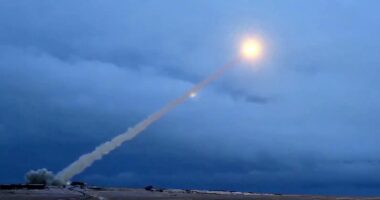Share this @internewscast.com
When Elon Musk’s SpaceX sent its enormous Starship rocket into space for the second time in November 2023, it not only set new records but also had an unexpected impact on the atmosphere.
Researchers have discovered that the sheer force of the launch temporarily pierced the upper atmospheric layers, resulting in a unique occurrence.
The rocket’s booster separated as planned, but four minutes later it exploded mid-air.
Starship itself then detonated about 93 miles above Earth shortly after.
The power of the second explosion was significant enough to tear through the ionosphere, a crucial atmospheric layer that influences radio communications and satellite transmissions.
According to researchers, this is the first time a hole in the ionosphere has been caused by a catastrophic event like a rocket explosion.
‘Usually, such holes form due to chemical reactions from engine fuel,’ explained Yury Yasyukevich, lead researcher and ionosphere physicist at the Russian Academy of Sciences’ Institute of Solar-Terrestrial Physics.
‘But this time, it was caused by the sheer shock wave from the Starship explosion.’
Using data from satellites and ground observatories, scientists observed the gaping hole remain open for 30 to 40 minutes — before the ionosphere naturally stitched itself back together.

Four minutes after lift-off, Starship’s booster detached as planned but then exploded in mid-air (pictured)
Yasyukevich’s research team used data from ground-based Global Navigation Satellite System (GNSS) receivers — devices that receive signals from satellites — to investigate how the Starship explosion affected the ionosphere.
This upper layer of Earth’s atmosphere is primarily made up of plasma: a mixture of neutral gas molecules, positively charged ions and free elections, which are electrons that have broken free of their parent atom and can move around independently.
The researchers’ analysis revealed that when Starship exploded, the resulting shock wave scattered the free electrons, temporarily disrupting the plasma and creating a ‘hole’ where the ionosphere’s usual properties were depleted.
It’s also possible that any rocket fuel that did not immediately burn up in the explosion could have interacted with the ionosphere and ‘reinforced the depletion and extended its duration,’ the researchers stated. But this was not the primary cause of the hole.
More research is needed to understand the effects of ionospheric holes. But this novel event offered Yasyukevich and his colleagues a rare opportunity to learn more about this layer of the atmosphere.
‘Analyzing the data and understanding their nature, we understand more deeply the structure of the ionosphere, [and] the nature of the phenomena that occur in it,’ Yasyukevich told TASS, a Russian news agency.
He and his colleagues published their study in the journal Geophysical Research Letters in August 2024.
The November 2023 explosion wasn’t the first or the last time SpaceX’s Starship blew up.

The incident occurred when Musk’s spaceflight company, SpaceX, launched the second Starship test flight from its Starbase test and manufacturing facility in Boca Chica, Texas

So far this year, Elon Musk’s SpaceX has yet to successfully launch Starship
The rocket met a similar fate during its first test flight in April 2023. That time, Starship was given a self-destruct code when it entered into an uncontrolled spin about four minutes after lifting off.
It was only 18 miles above ground when it blew and rained chunks of debris down over Boca Chica, prompting a federal investigation and a lawsuit from environmental groups.
Since that inaugural test flight, Starship has been launched seven more times for a total of eight test flights. Four of them have been explosive failures.
So far this year, SpaceX has yet to successfully launch Starship.
Flights seven and eight — which occurred on January 16 and March 6, respectively — saw the booster successfully return to Starbase, where it was caught by the launch tower’s ‘chopstick’ arms.
But the upper stage exploded 10 minutes after lift off during both flights, dropping debris over areas along the flight path including the Turks and Caicos islands and The Bahamas.
SpaceX is currently preparing for the rocket’s ninth test flight, which is supposed to happen no earlier than May 20.

















